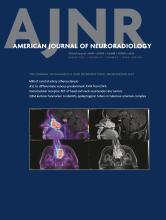Index by author
Baranoski, J.F.
- NeurointerventionYou have accessEndovascular Treatment of Cerebrovascular Lesions Using Nickel- or Nitinol-Containing Devices in Patients with Nickel AllergiesJ.F. Baranoski, J.S. Catapano, C. Rutledge, T.S. Cole, N. Majmundar, E.A. Winkler, V.M. Srinivasan, A.P. Jadhav, A.F. Ducruet and F.C. AlbuquerqueAmerican Journal of Neuroradiology August 2023, 44 (8) 939-942; DOI: https://doi.org/10.3174/ajnr.A7936
Bash, S.C.
- Spine Imaging and Spine Image-Guided InterventionsYou have accessDeep Learning–Generated Synthetic MR Imaging STIR Spine Images Are Superior in Image Quality and Diagnostically Equivalent to Conventional STIR: A Multicenter, Multireader TrialL.N. Tanenbaum, S.C. Bash, G. Zaharchuk, A. Shankaranarayanan, R. Chamberlain, M. Wintermark, C. Beaulieu, M. Novick and L. WangAmerican Journal of Neuroradiology August 2023, 44 (8) 987-993; DOI: https://doi.org/10.3174/ajnr.A7920
Bathla, G.
- FELLOWS' JOURNAL CLUBExtracranial VascularOpen AccessMR Imaging of Carotid Artery Atherosclerosis: Updated Evidence on High-Risk Plaque Features and Emerging TrendsJ.C. Benson, L. Saba, G. Bathla, W. Brinjikji, V. Nardi and G. LanzinoAmerican Journal of Neuroradiology August 2023, 44 (8) 880-888; DOI: https://doi.org/10.3174/ajnr.A7921
MR imaging is the criterion standard for carotid artery plaque characterization and is best able to characterize features of plaque vulnerability: lipid-rich necrotic core, intraplaque hemorrhage, ulcerations, loss of fibrous integrity, maximum plaque thickness, and plaque enhancement. Many researchers believe that many embolic strokes of undetermined source may originate from nonstenotic ipsilateral carotid plaques with vulnerable features. From the results of many trials, many believe that imaging markers of plaque vulnerability should be considered in the determination of carotid endarterectomy eligibility.
Beaulieu, C.
- Spine Imaging and Spine Image-Guided InterventionsYou have accessDeep Learning–Generated Synthetic MR Imaging STIR Spine Images Are Superior in Image Quality and Diagnostically Equivalent to Conventional STIR: A Multicenter, Multireader TrialL.N. Tanenbaum, S.C. Bash, G. Zaharchuk, A. Shankaranarayanan, R. Chamberlain, M. Wintermark, C. Beaulieu, M. Novick and L. WangAmerican Journal of Neuroradiology August 2023, 44 (8) 987-993; DOI: https://doi.org/10.3174/ajnr.A7920
Benson, J.C.
- FELLOWS' JOURNAL CLUBExtracranial VascularOpen AccessMR Imaging of Carotid Artery Atherosclerosis: Updated Evidence on High-Risk Plaque Features and Emerging TrendsJ.C. Benson, L. Saba, G. Bathla, W. Brinjikji, V. Nardi and G. LanzinoAmerican Journal of Neuroradiology August 2023, 44 (8) 880-888; DOI: https://doi.org/10.3174/ajnr.A7921
MR imaging is the criterion standard for carotid artery plaque characterization and is best able to characterize features of plaque vulnerability: lipid-rich necrotic core, intraplaque hemorrhage, ulcerations, loss of fibrous integrity, maximum plaque thickness, and plaque enhancement. Many researchers believe that many embolic strokes of undetermined source may originate from nonstenotic ipsilateral carotid plaques with vulnerable features. From the results of many trials, many believe that imaging markers of plaque vulnerability should be considered in the determination of carotid endarterectomy eligibility.
Betts, A.M.
- FELLOWS' JOURNAL CLUBHead and Neck ImagingOpen AccessReliable Initial Trauma CT Findings of Supraclavicular Brachial Plexus Injury in Patients Sustaining Blunt InjuriesM.R. Povlow, J.R. Davis, A.M. Betts, S.M. Clayton, F.J. Cloran, J.K. Aden and J.L. RitterAmerican Journal of Neuroradiology August 2023, 44 (8) 951-958; DOI: https://doi.org/10.3174/ajnr.A7919
A case (n = 36) - control (n = 50) study aimed to identify CT findings of supraclavicular brachial plexus injuries to discern who may require further evaluation with MR imaging. The results showed that scalene muscle edema/enlargement and interscalene fat pad effacement were most strongly associated with brachial plexus injury and demonstrated good sensitivity and specificity. These findings are best assessed with a soft-tissue reconstruction kernel; therefore, this should be incorporated as part of the trauma CT cervical spine assessment.
Bian, B.
- Pediatric NeuroimagingOpen AccessGlutaric Aciduria Type 1: Comparison between Diffusional Kurtosis Imaging and Conventional MR ImagingB. Bian, Z. Liu, D. Feng, W. Li, L. Wang, Y. Li and D. LiAmerican Journal of Neuroradiology August 2023, 44 (8) 967-973; DOI: https://doi.org/10.3174/ajnr.A7928
Bokkers, R.P.H.
- NeurointerventionYou have accessClinical Applications of Conebeam CTP Imaging in Cerebral Disease: A Systematic ReviewA.H.A. Zaid Al-Kaylani, R.C.L. Schuurmann, W.D. Maathuis, R.H.J.A. Slart, J.-P.P.M. de Vries and R.P.H. BokkersAmerican Journal of Neuroradiology August 2023, 44 (8) 922-927; DOI: https://doi.org/10.3174/ajnr.A7930
Boomgaert, L.
- EDITOR'S CHOICEAdult BrainYou have accessPerformance of Automated ASPECTS Software and Value as a Computer-Aided Detection ToolJ. Lambert, J. Demeestere, B. Dewachter, L. Cockmartin, A. Wouters, R. Symons, L. Boomgaert, L. Vandewalle, L. Scheldeman, P. Demaerel and R. LemmensAmerican Journal of Neuroradiology August 2023, 44 (8) 894-900; DOI: https://doi.org/10.3174/ajnr.A7956
This retrospective study compared the agreement of automated ASPECTS and raters with a different experience level in scoring patients with acute ischemic stroke with large-vessel occlusion undergoing thrombectomy. The agreement of all raters individually versus the criterion standard and interrater agreement improved with software assistance.
Branstetter, B.F.
- FELLOWS' JOURNAL CLUBHead and Neck ImagingYou have accessEcchordosis Physaliphora: Does It Even Exist?A.R. Stevens, B.F. Branstetter, P. Gardner, T.M. Pearce, G.A. Zenonos and K. AraniAmerican Journal of Neuroradiology August 2023, 44 (8) 889-893; DOI: https://doi.org/10.3174/ajnr.A7932
Notochordal lesions span a spectrum of disease ranging from benign notochordal remnant (ecchordosis physaliphora) to low-grade to aggressively malignant. Benign notochordal remnant cannot be reliably distinguished from low-grade chordoma as they may have overlapping imaging features. Repeat imaging, beginning at 6-month intervals, is a more clinically relevant method for evaluating the malignant potential of these lesions.








